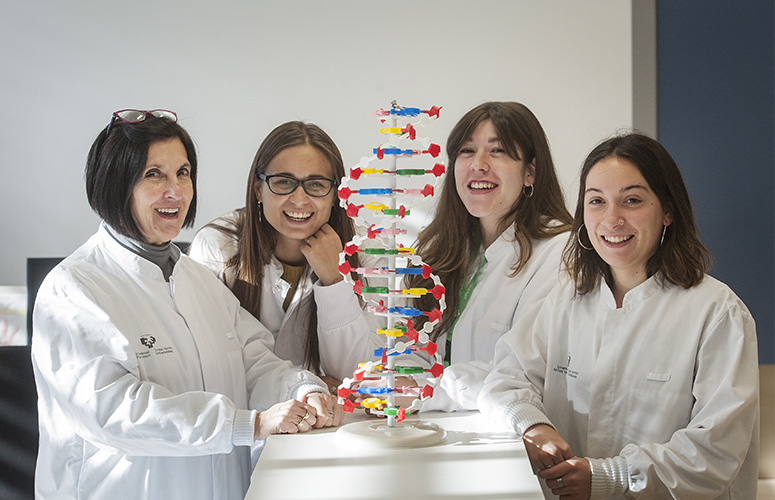The UPV/EHU’s BIOMICs research group has studied the presence of the DF27 haplogroup in the mestizo population of Latin America. The study reveals an average frequency of 29-35%, with an increasing north-south pattern that appears to concur with the influence of trade routes with Latin America of the colonial era. The presence of this haplogroup in a forensic context could be due to individuals of both European origin and of Latin American origin.
A type of Y chromosome characteristic of Basques in the Latin American mestizo population
The UPV/EHU-University of the Basque Country links the presence of a haplogroup in the Latin American mestizo population with trade routes with Latin America of the colonial era
- Research
First publication date: 05/12/2019

The Y chromosome of the human species is one of the sexual chromosomes present in male individuals. “It is a lineage marker and tells us about the biological history of populations. It is also very important in forensic genetics,” explained Marian Martínez de Pancorbo, lead researcher in the UPV/EHU's BIOMICs group. For years the BIOMICs research group has been combining, among other things, the study of the Y chromosome with enhanced knowledge about new markers for population genetics and for applying to forensic genetics.
“Little by little we have been coming across peculiarities in the DNA of our population, among whom the DF27 haplogroup is to be found,” says Martínez de Pancorbo, a UPV/EHU professor. Haplogroups of the Y chromosome are sets of markers or genetic characteristics located within this chromosome. “We come across an extremely high frequency of this haplogroup in the Basque Country and also a high frequency in Cantabria and Aragon. As we search in Asturias, Galicia or Catalonia, the frequency of the haplogroup gradually becomes diluted,” she added.
Bearing in mind that historically the Basque population has emigrated a lot, “we believed it would be interesting to look for DF27 among American mestizos”, explained the researcher. So a study was conducted in Mexico, Guatemala, El Salvador, Nicaragua, Panama, Colombia and Puerto Rico, and it was confirmed that “in actual fact, individuals of Basque origin have left offspring in Latin America”, she added.
Haplogroups that come and go
The DF27 haplogroup in the Latin American populations studied reveals a frequency of between 9 and 37 %. The frequency is higher in Colombia and lower in El Salvador; it has also been found to follow a decreasing pattern from south to north. This distribution pattern seems to concur with the trade routes with Latin America during the colonial era, and a higher frequency where the commercial link was more intense can be seen. “Our results have been endorsed by Oscar Álvarez-Gila, the PhD holder in history of the UPV/EHU’s Department of Medieval, Modern and Latin American History, precisely due to the fact that Cartagena de Indias (Colombia) is in fact an area where trade from the Iberian Peninsula towards Latin America was centralised,” said Martínez de Pancorbo.
The professor stresses the need to analyse the presence of the haplogroup in other Latin American countries such as Paraguay, Argentina, etc., as well as in North America to obtain a more detailed picture of its distribution. She also says that they “would like to conduct a study in the Philippines since it is another of the places historically reached by Basques, and that way we would have a complete map of what is actually taking place with respect to this paternal lineage across the world”. The researcher highlighted the difficulties they encounter when taking samples in situ: in fact, she said that to do this it is essential to establish many and good relations, which she assumes they have had until now.
Finally, Martínez de Pancorbo said that from a forensic perspective “the fact that a DF27 haplogroup was found in vestiges of a forensic context is interesting, but it is necessary to exercise caution when interpreting it, because it could just as easily come from an individual in the north of the Iberian Peninsula as from an individual from Latin America, bearing in mind the large number of individuals originating from Latin America currently living in this area”.
Additional information
Marian Martínez de Pancorbo is professor of Cell Biology at the UPV/EHU, head of the UPV/EHU’s DNA Bank and lead researcher in the BIOMICs reaearch group. BIOMICs is a multidisciplinary group that conducts research into biosciences and microtechnologies at the Lascaray Research Centre on the Araba campus; it is involved in three sets of research lines: Genetic variability, Biomedicine and Microfluidics. Genetic Variability, divided into Genetics of Human Populations, Forensic Genetics, Forensic Biology and Animal Genetic Diversity, and Archaeogenetics, explores genetic, human and animal genetics to characterise individuals and populations and provide data of an evolutionary nature. BIOMICs has also developed other new methodologies to facilitate this research. In Biomedicine, BIOMICs has focussed on epigenetics, gearing itself towards new discoveries that impact on the prevention, diagnosis and treatment of breast and colon cancer, as well as on aging and Alzheimer’s and Parkinson’s diseases.
Bibliographic reference
- The impact of haplogroup R1b-DF27 in Hispanic admixed populations from Latin America
- Forensic Science International: Genetics Supplement Series
- DOI: 10.1016/j.fsigss.2019.10.062

